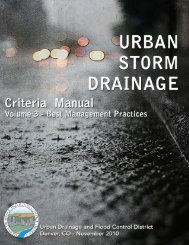Hydraulic Efficiency of Grate and Curb Inlets - Urban Drainage and ...
Hydraulic Efficiency of Grate and Curb Inlets - Urban Drainage and ...
Hydraulic Efficiency of Grate and Curb Inlets - Urban Drainage and ...
Create successful ePaper yourself
Turn your PDF publications into a flip-book with our unique Google optimized e-Paper software.
Empirical<br />
1<br />
0.9<br />
0.8<br />
0.7<br />
0.6<br />
0.5<br />
0.4<br />
0.3<br />
0.2<br />
0.1<br />
0<br />
1 ft depth<br />
0.5 ft depth<br />
0.33 ft depth<br />
Equal<br />
0 0.1 0.2 0.3 0.4 0.5 0.6 0.7 0.8 0.9 1<br />
UDFCD new<br />
Figure 5-13: Type R curb inlet efficiency comparison<br />
A sensitivity analysis was performed on each <strong>of</strong> the variables in Equation 5-8 through<br />
Equation 5-10 to quantify the magnitude <strong>of</strong> change in efficiency from a change in any <strong>of</strong> the<br />
independent variables, results are presented in Figure 5-14 through Figure 5-16, respectively.<br />
Base values for each parameter were chosen as the median values observed in testing. Each<br />
parameter was varied throughout the range <strong>of</strong> test conditions while other parameters were held at<br />
their base values, which produced a range <strong>of</strong> values for efficiency. Normalizing each parameter<br />
value <strong>and</strong> corresponding efficiency by their base values then produced a curve centered about<br />
one. Use <strong>of</strong> these figures allows for quantification <strong>of</strong> the effects from varying each parameter on<br />
inlet efficiency. For example, when the Type 13 <strong>and</strong> 16 combination inlets are increased in<br />
length by 50% the efficiency increases by approximately 20%. For the Type R curb inlet a 50 %<br />
increase in length results in an efficiency increase <strong>of</strong> about 40%. A similar comparison could be<br />
made for flow velocity, depth, or top width <strong>of</strong> flow. As expected, the equations are most<br />
sensitive to changes in velocity <strong>and</strong> flow area (or depth in the case <strong>of</strong> the Type R curb inlet).<br />
The Type 16 is less sensitive to changes in velocity than the Type 13 due to the directional vanes<br />
on the grate. Type 16 <strong>and</strong> 13 equations are least sensitive to changes in inlet length due to most<br />
flow entering the first grate for those inlets, whereas the Type R equation is least sensitive to<br />
changes in street cross slope due to the deep local inlet depression.<br />
68
















